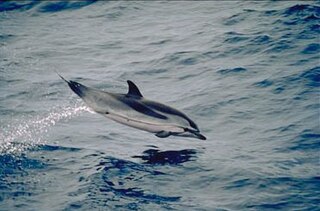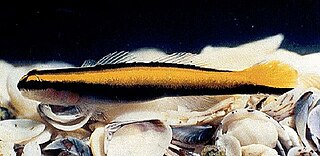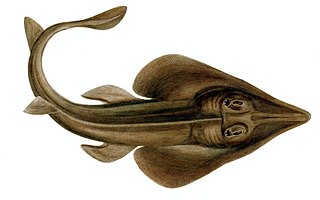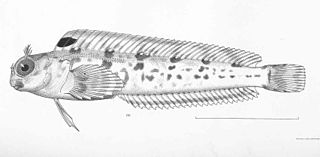 W
WAglaophenia pluma, the toothed feather hydroid or podded hydroid, is a colonial hydroid in the family Aglaopheniidae and is found worldwide. It lives from the shore to 120m under water.
 W
WAnablepidae is a family of fishes which live in brackish and freshwater habitats from southern Mexico to southern South America. There are three genera with sixteen species: the four-eyed fishes, the onesided livebearers and the white-eye, Oxyzygonectes dovii. Fish of this family eat mostly insects and other invertebrates.
 W
WAntipatharians, also known as black corals or thorn corals, are an order of soft deep-water corals. These corals can be recognized by their jet-black or dark brown chitin skeletons, surrounded by the polyps. Antipatharians are a cosmopolitan order, existing at nearly every location and depth, with the sole exception of brackish waters. However, they are most frequently found on continental slopes under 50 m (164 ft) deep. A black coral reproduces both sexually and asexually throughout its lifetime. Many black corals provide housing, shelter, food, and protection for other animals.
 W
WCommerson's dolphin, also referred to by the common names jacobita, skunk dolphin, piebald dolphin or panda dolphin, is a small oceanic dolphin of the genus Cephalorhynchus. Commerson's dolphin has two geographically-isolated but locally-common subspecies. The principal subspecies, C.c.commersonii, has sharply-delineated black-and-white patterning and is found around the tip of South America. The secondary subspecies, C.c.kerguelenensis, is larger than C.c.commersonii, has a less-sharply delineated dark and light grey patterning with a white ventral band, and is found around the Kerguelen Islands in the Indian Ocean.
 W
WPeale's dolphin is a small dolphin found in the waters around Tierra del Fuego at the foot of South America. It is also commonly known as the black-chinned dolphin or even Peale's black-chinned dolphin. However, since Rice's work Peale's dolphin has been adopted as the standard common name.
 W
WThe Atlantic spotted dolphin is a dolphin found in the Gulf Stream of the North Atlantic Ocean. Older members of the species have a very distinctive spotted coloration all over their bodies.
 W
WThe striped dolphin is an extensively studied dolphin found in temperate and tropical waters of all the world's oceans. It is a member of the oceanic dolphin family, Delphinidae.
 W
WElacatinus figaro, the barber goby or yellow line goby, is a colourful species of marine goby, family Gobiidae, from the southwestern Atlantic, where it is endemic to the coastal waters of Brazil.
 W
WElacatinus puncticulatus is a species of goby from the eastern central Pacific Ocean where it is found on reefs from the Gulf of California to Ecuador. This species occurs at depths of from 2 to 6 m, usually in association with the sea urchin Eucidaris thouarsii. It grows to a standard length of 4.4 cm (1.7 in). It occasionally is found in the aquarium trade.
 W
WThe four-eyed fishes are a genus, Anableps, of fishes in the family Anablepidae. They have eyes raised above the top of the head and divided in two different parts, so that they can see below and above the water surface at the same time.
 W
WThe Guiana dolphin, also known as the estuarine dolphin or costero, is a dolphin found in the coastal waters to the north and east of South America, and east of Central America. It is a member of the oceanic dolphin family (Delphinidae). It can live in both saltwater and freshwater.
 W
WThe Brazilian guitarfish is a species of fish in the family Rhinobatidae. It is endemic to Brazil, where its natural habitat is coastal waters on the continental shelf. This fish is viviparous and has a long gestation period, concluding with the birth of live pups in February. At this time the fish are subject to intense fishing activity but catches have been dwindling in recent years as a result of overfishing. Because so few breeding-size fish remain, the International Union for Conservation of Nature has assessed the fish's conservation status as being "critically endangered".
 W
WThe smalleye hammerhead, also called the golden hammerhead or curry shark, is a small species of hammerhead shark, belonging to the family Sphyrnidae. This species is common in the shallow coastal waters of the western Atlantic Ocean, from Venezuela to Uruguay. It favors muddy habitats with poor visibility, reflected by its relatively small eyes. Adult males and juveniles are schooling and generally found apart from the solitary adult females. Typically reaching 1.2–1.3 m (3.9–4.3 ft) in length, this shark has a unique, bright golden color on its head, sides, and fins, which was only scientifically documented in the 1980s. As in all hammerheads, its head is flattened and laterally expanded into a hammer-shaped structure called the cephalofoil, which in this species is wide and long with an arched front margin bearing central and lateral indentations.
 W
WThe sun star (Heliaster helianthus) is a species of Asteroidea (starfish) in the family Heliasteridae. It is found in shallow water rocky habitats and in the kelp forests off the Pacific coast of Ecuador, Peru and Chile.
 W
WThe La Plata dolphin, franciscana or toninha is a species of dolphin found in coastal Atlantic waters of southeastern South America. It is a member of the river dolphin group and the only one that lives in the ocean and saltwater estuaries, rather than inhabiting exclusively freshwater systems. Commercialized areas that create agricultural runoffs and/or industrialized zones can affect the health of the La Plata dolphin, especially in regards to their contributions of waste and pollution, which can lead to habitat degradation and poisoned food among other concerns.
 W
WLuidia senegalensis, the nine-armed sea star, is a tropical species of starfish in the family Luidiidae found in the western Atlantic Ocean.
 W
WMeyenaster is a genus of starfish in the family Asteriidae. It is a monotypic genus and the only species is Meyenaster gelatinosus which was first described by the Prussian botanist and zoologist Franz Julius Ferdinand Meyen in 1834. It is found in the southeastern Pacific Ocean on the coasts of South America.
 W
WThe marine otter is a rare and relatively unknown South American mammal of the weasel family (Mustelidae). The scientific name means "otter cat", and in Spanish, the marine otter is also often referred to as gato marino: "marine cat". The marine otter only lives in saltwater, coastal environments and rarely ventures into freshwater or estuarine habitats. This saltwater exclusivity is unlike most other otter species, except for the almost fully aquatic sea otter of the North Pacific.
 W
WParahypsos piersoni is a species of combtooth blenny found in coral reefs in the eastern Pacific ocean, from Costa Rica to Peru. The specific name honours C.J. Pierson, who was a member of the expedition to Panama on which the type was collected.
 W
WPocillopora meandrina, commonly known as cauliflower coral, is a species of coral occurring in the Indo-Pacific and Pacific oceans. This coral lives in shallow reef environments.
 W
WPorites astreoides, commonly known as mustard hill coral or yellow porites, is a colonial species of stony coral in the family Poritidae.
 W
WPorites furcata, commonly known as hump coral, thin finger coral or branched finger coral, is a species of stony coral in the genus Porites. It is found in the Caribbean Sea and western Atlantic Ocean.
 W
WPorites porites, commonly known as hump coral or finger coral, is a species of stony coral in the genus Porites. It is found in the Caribbean Sea and western Atlantic Ocean and also along the coast of West Africa.
 W
WThe daggernose shark is a little-known species of requiem shark, in the family Carcharhinidae, and the only extant member of its genus. It inhabits shallow tropical waters off northeastern South America, from Trinidad to northern Brazil, favoring muddy habitats such as mangroves, estuaries, and river mouths, though it is intolerant of fresh water. A relatively small shark typically reaching 1.5 m (4.9 ft) in length, the daggernose shark is unmistakable for its elongated, flattened, and pointed snout, tiny eyes, and large paddle-shaped pectoral fins.
 W
WThe school shark is a houndshark of the family Triakidae, and the only member of the genus Galeorhinus. Common names also include tope shark, snapper shark, and soupfin shark. It is found worldwide in temperate seas at depths down to about 800 m (2,600 ft). It can grow to nearly 2 m long. It feeds both in midwater and near the seabed, and its reproduction is ovoviviparous. This shark is caught in fisheries for its flesh, its fins, and its liver, which has a very high vitamin A content. The IUCN has classified this species as critically endangered in its Red List of Threatened Species.
 W
WStenopus hispidus is a shrimp-like decapod crustacean belonging to the infraorder Stenopodidea. Common names include banded coral shrimp and banded cleaner shrimp.
 W
WThe pygmy sperm whale is one of two extant species in the family Kogiidae in the sperm whale superfamily. They are not often sighted at sea, and most of what is known about them comes from the examination of stranded specimens.